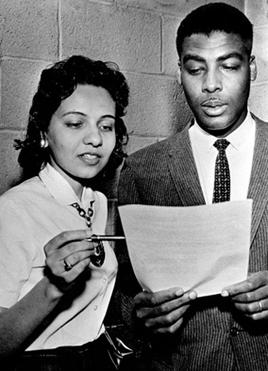Nashville sit-ins
Nashville sit-ins
The Nashville sit-ins were a series of non-violent protests that took place in Nashville, Tennessee, beginning on February 13, 1960, and lasting for several months. These sit-ins were part of a wider Civil Rights Movement aimed at ending racial segregation in the United States. The Nashville sit-ins were particularly significant for their highly organized nature, the involvement of young African-American college students, and their role in challenging racial segregation in public spaces, especially at lunch counters in downtown Nashville.
Background[edit | edit source]
The sit-ins in Nashville were inspired by the successful Greensboro sit-ins that began on February 1, 1960, in Greensboro, North Carolina. Nashville's African-American community, including students from local colleges like Fisk University, Tennessee State University, and American Baptist College, had already been active in the fight against segregation. The Nashville Student Movement, led by figures such as John Lewis, Diane Nash, James Bevel, and C.T. Vivian, was instrumental in organizing the sit-ins.
The Sit-ins[edit | edit source]
The first sit-in in Nashville took place at three downtown lunch counters on February 13, 1960. The protesters, dressed in their best clothes, sat at the lunch counters and politely asked for service, which was denied to them because of their race. When asked to leave, they remained seated, embodying the principles of non-violent resistance taught by Martin Luther King Jr. and practiced by the Southern Christian Leadership Conference (SCLC).
The sit-ins quickly expanded to other lunch counters and businesses in Nashville, leading to arrests and jail time for many of the participants. Despite this, the students remained non-violent, even in the face of physical assaults and harassment from opponents of integration.
Impact[edit | edit source]
The Nashville sit-ins were notable for their disciplined adherence to non-violence, the involvement of the local African-American community, and the support from some members of the white community. The protests led to the establishment of a negotiation committee that included city officials, business leaders, and representatives of the sit-in movement.
On May 10, 1960, after months of protests and negotiations, Nashville became the first major Southern city to begin desegregating its public facilities. The success of the Nashville sit-ins inspired similar actions in other cities across the South and marked a significant victory for the Civil Rights Movement.
Legacy[edit | edit source]
The Nashville sit-ins have left a lasting legacy in the fight for civil rights in America. Many of the movement's leaders went on to play significant roles in other civil rights actions, including the Freedom Rides, the March on Washington, and the Selma to Montgomery marches. The sit-ins also contributed to the eventual passage of the Civil Rights Act of 1964, which outlawed segregation in public places and employment discrimination on the basis of race, color, religion, sex, or national origin.
The story of the Nashville sit-ins is a testament to the power of non-violent protest and the impact that organized, peaceful resistance can have on social change.
Navigation: Wellness - Encyclopedia - Health topics - Disease Index - Drugs - World Directory - Gray's Anatomy - Keto diet - Recipes
Search WikiMD
Ad.Tired of being Overweight? Try W8MD's physician weight loss program.
Semaglutide (Ozempic / Wegovy and Tirzepatide (Mounjaro / Zepbound) available.
Advertise on WikiMD
WikiMD is not a substitute for professional medical advice. See full disclaimer.
Credits:Most images are courtesy of Wikimedia commons, and templates Wikipedia, licensed under CC BY SA or similar.Contributors: Prab R. Tumpati, MD






